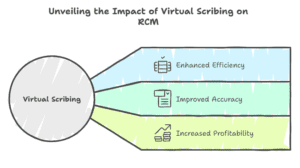Revenue Cycle Management (RCM) is a critical component of healthcare organizations’ financial health, impacting everything from patient billing and coding to claims submission and payment collection. One of the emerging trends in healthcare that can significantly improve RCM profitability is the use of virtual scribing. Virtual scribing allows healthcare providers to focus more on patient care while outsourcing the documentation process to trained professionals. By improving documentation accuracy and efficiency, virtual scribing enhances RCM profitability in several ways.
In this article, we will explore how virtual scribing impacts RCM profitability by reducing administrative burdens, improving efficiency, and increasing revenue.
Why Virtual Scribing is Becoming Essential in Healthcare
Healthcare providers, particularly physicians, often spend a significant portion of their time documenting patient interactions. This time could be better spent on providing care or improving clinical outcomes. The advent of virtual scribing allows healthcare organizations to outsource this time-consuming task to trained scribes who assist with documenting patient encounters in real-time.
The key benefits of virtual scribing include:
- Increased focus on patient care: By offloading documentation tasks, healthcare providers can spend more time engaging with patients and providing care.
- Improved accuracy in documentation: Virtual scribes ensure that clinical documentation is accurate, reducing the risk of coding errors and improving the quality of medical records.
- Cost savings: Outsourcing scribing reduces the need to hire additional in-house staff, leading to savings on salaries, training, and benefits.
Virtual scribing is becoming increasingly popular for improving RCM processes, especially for practices that want to increase efficiency, accuracy, and profitability.
How Virtual Scribing Affects RCM Profitability

1. Improved Coding Accuracy
Accurate documentation is essential for proper coding, which directly affects reimbursement rates. Virtual scribing improves coding accuracy by ensuring that all relevant clinical details are captured correctly during the patient encounter. Benefits include:
- Fewer coding errors: Virtual scribes help ensure that the right codes are applied to services provided, reducing the likelihood of denials and rejections.
- Better compliance with payer requirements: Accurate documentation helps healthcare providers meet payer requirements, ensuring that claims are processed smoothly.
- Higher reimbursement rates: With more accurate coding, healthcare organizations can submit claims that are properly supported by medical records, which leads to faster payments and fewer issues with reimbursement.
2. Increased Efficiency and Faster Claim Submission
Virtual scribing allows healthcare providers to reduce the time spent on administrative tasks, enabling faster claim submission and better overall efficiency. Key advantages include:
- Reduced documentation time: Virtual scribes handle documentation in real-time, reducing the amount of time physicians spend on note-taking and paperwork.
- Faster claim processing: With accurate, complete, and timely documentation, claims can be submitted more quickly, leading to faster reimbursements.
- Improved workflow: By streamlining the documentation process, virtual scribing helps healthcare practices operate more efficiently, reducing bottlenecks and improving the overall workflow of the revenue cycle.
3. Reduced Denials and Rework
Denial management is a key area that can greatly affect the profitability of an RCM system. Virtual scribing helps reduce the risk of claim denials by ensuring that medical records are complete and accurate. Benefits include:
- Decreased claim denials: Proper documentation ensures that claims are submitted with the correct codes and supporting information, reducing the risk of denials due to insufficient documentation.
- Fewer rework cycles: With accurate, timely documentation, there is less need for rework when submitting claims, improving overall efficiency and reducing administrative costs.
- Lower administrative overhead: Fewer denied claims and less rework mean that the RCM team can focus on more valuable tasks, reducing administrative burden and costs.
4. Cost Savings on Administrative Staffing
Virtual scribing offers significant cost savings for healthcare organizations by reducing the need for in-house medical scribes or transcriptionists. Cost-related benefits include:
- Lower overhead costs: By outsourcing scribing, practices don’t have to hire, train, or maintain full-time in-house staff, leading to lower payroll expenses.
- Flexible staffing models: Virtual scribing services are often flexible, allowing practices to scale up or down depending on the volume of patients or specific needs.
- Increased ROI: By reducing overhead costs and improving RCM efficiency, virtual scribing can directly contribute to a higher return on investment (ROI) for healthcare practices.
5. Enhanced Patient Satisfaction
Virtual scribing also has an impact on patient satisfaction, which can indirectly affect RCM profitability. When healthcare providers are not bogged down by excessive administrative tasks, they can focus more on patient care. Key advantages include:
- More patient engagement: With virtual scribes handling documentation, providers can dedicate more time to interacting with patients and addressing their concerns.
- Better patient experience: Patients often feel more valued when healthcare providers can spend more time focused on them rather than on administrative tasks.
- Improved patient retention: A positive patient experience can lead to higher patient retention rates, which helps sustain a steady revenue stream for the practice.
6. Improved Reporting and Analytics
Virtual scribing can contribute to better reporting and analytics, which are critical for optimizing the revenue cycle and improving financial performance. Benefits include:
- Accurate and comprehensive reports: With better documentation, healthcare practices can generate more accurate reports that reflect their financial performance and patient care outcomes.
- Data-driven decision making: Accurate data allows healthcare administrators to identify trends, improve processes, and make informed decisions to enhance profitability.
- Better forecasting and planning: With consistent, reliable data from virtual scribing, practices can better forecast future revenue, set financial goals, and plan for growth.
7. Scalability
As healthcare practices grow, the demands on administrative tasks like documentation increase. Virtual scribing helps ensure that practices can scale their operations without sacrificing efficiency or accuracy. Scalability benefits include:
- Handling higher patient volumes: Virtual scribing can easily scale to accommodate more patients, ensuring that documentation remains accurate and efficient as the practice grows.
- Support for expanding services: As healthcare practices add new services or specialties, virtual scribing can support the additional documentation needs without requiring additional staff.
- Adaptability: Virtual scribing services can quickly adapt to changes in a practice’s workflow or needs, ensuring that documentation processes remain smooth as the organization evolves.
Conclusion
Virtual scribing is a powerful tool for improving RCM profitability by increasing documentation accuracy, reducing denials, enhancing operational efficiency, and saving costs on administrative staffing. By outsourcing scribing to trained professionals, healthcare providers can focus on what matters most—providing quality care—while ensuring that their revenue cycle is optimized for maximum profitability. As healthcare practices continue to grow and evolve, virtual scribing can play a crucial role in supporting scalable, sustainable financial success.
What People Are Asking
1. How does virtual scribing impact RCM profitability?
Virtual scribing improves RCM profitability by enhancing documentation accuracy, reducing claim denials, speeding up claim submission, and decreasing administrative costs.
2. Can virtual scribing help reduce claim denials?
Yes, virtual scribing ensures that documentation is complete and accurate, reducing the likelihood of claim denials due to coding errors or insufficient information.
3. How does virtual scribing save on costs for healthcare practices?
Virtual scribing reduces the need for in-house administrative staff, saving on salaries, training, and benefits, while improving operational efficiency.
4. How does virtual scribing improve patient satisfaction?
By allowing healthcare providers to focus more on patient care instead of documentation, virtual scribing enhances the patient experience and engagement.
5. How does virtual scribing support scalability in healthcare practices?
Virtual scribing can easily scale with increasing patient volumes and expanding services, ensuring that documentation processes remain efficient as the practice grows.
Disclaimer
For informational purposes only; not applicable to specific situations.
For tailored support and professional services,
please contact Staffingly, Inc. at (800) 489-5877
Email: support@staffingly.com.
About This Blog: This Blog is brought to you by Staffingly, Inc., a trusted name in healthcare outsourcing. The team of skilled healthcare specialists and content creators is dedicated to improving the quality and efficiency of healthcare services. The team passionate about sharing knowledge through insightful articles, blogs, and other educational resources.
 Book a Demo to Build Your Team Today!
Book a Demo to Build Your Team Today!

 Read Case Studies
Read Case Studies 



 Virtual Medical Assistants
Virtual Medical Assistants



